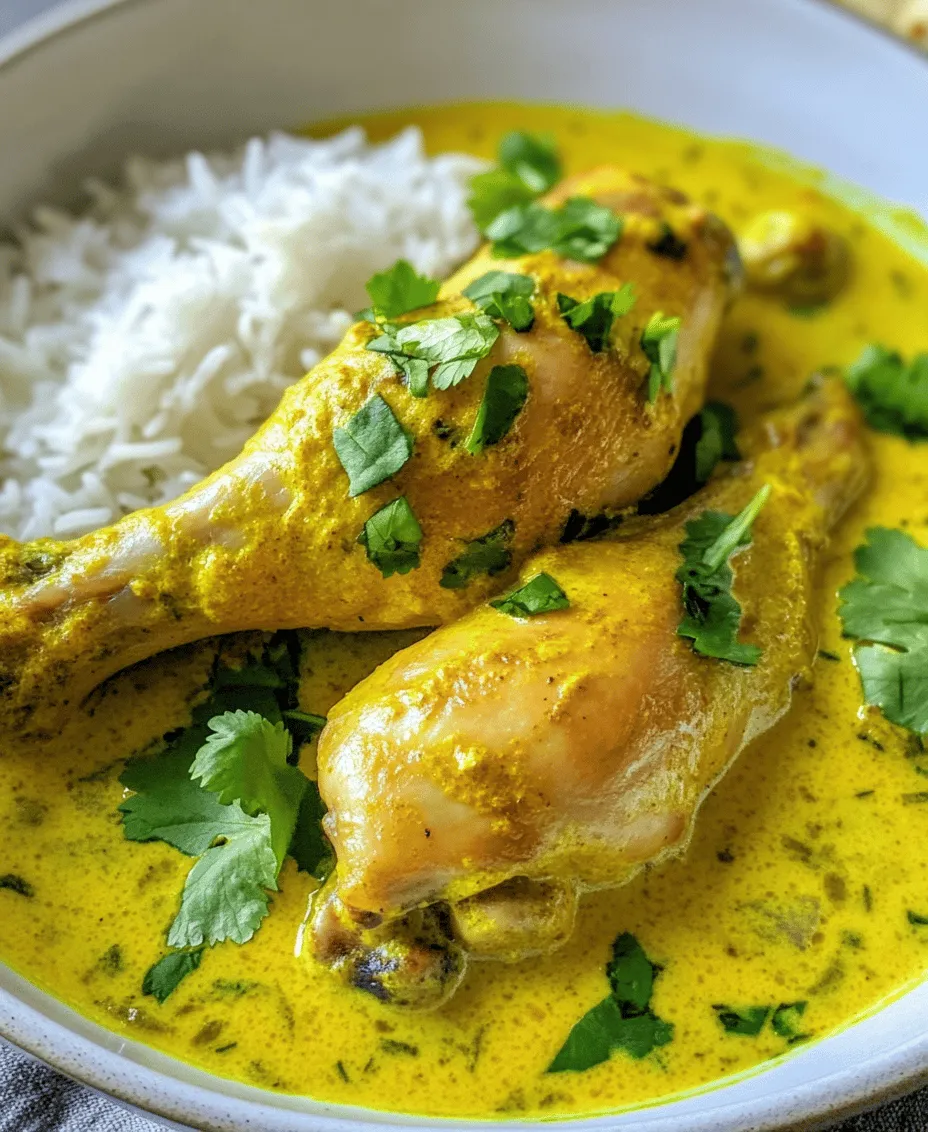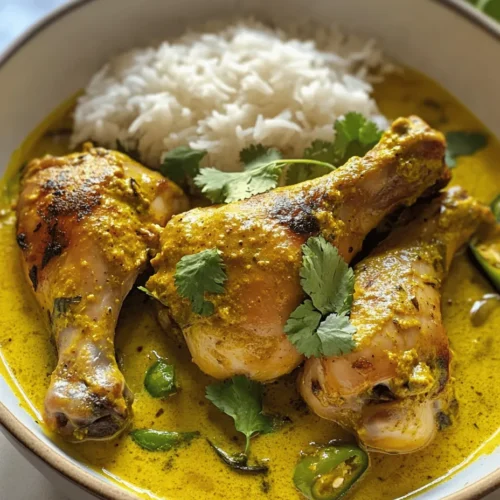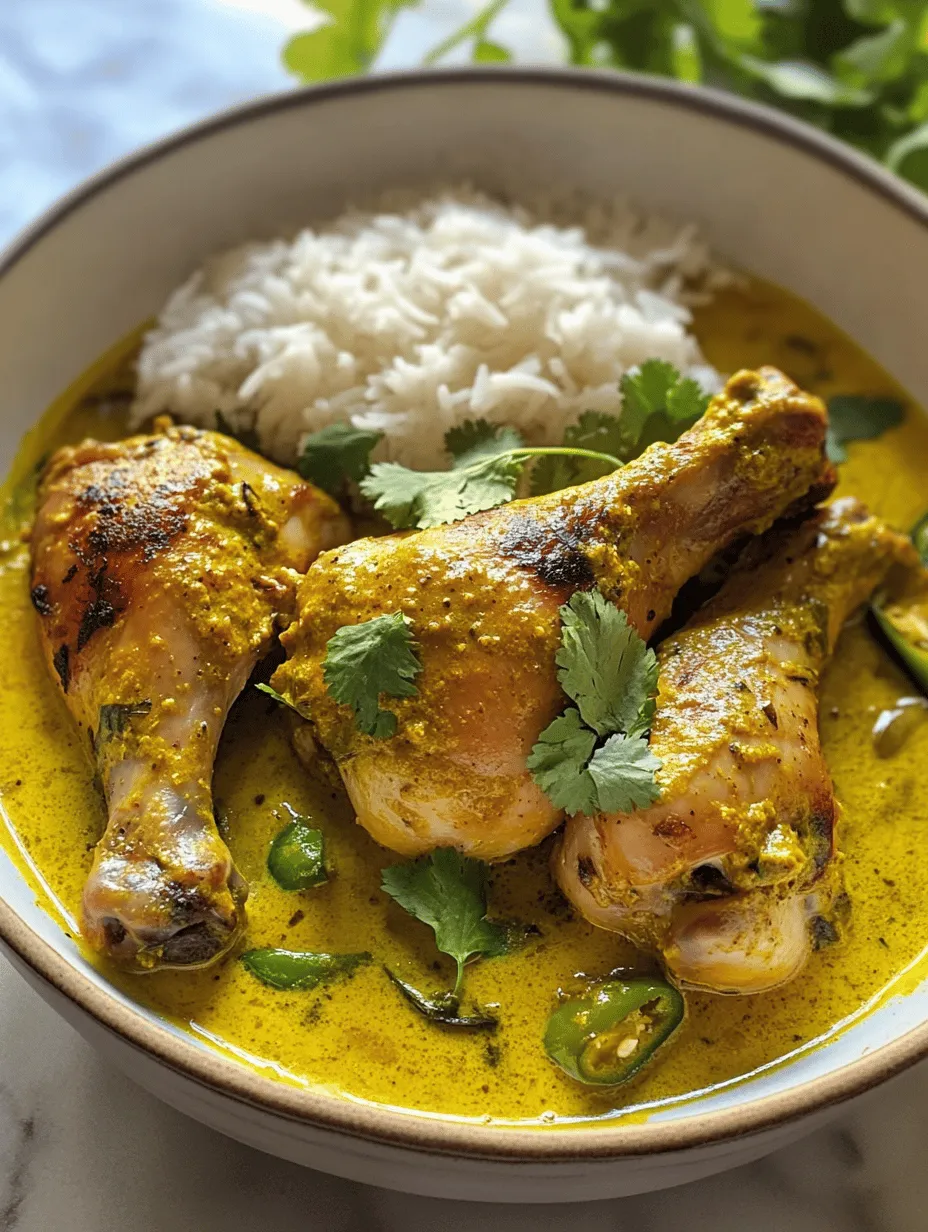Introduction
Kuku Paka, a beloved dish from East Africa, beautifully marries the rich flavors of coconut with tender chicken and a medley of spices. This dish is not only delicious but also holds a special place in the culinary traditions of countries like Kenya and Tanzania, where it is often served during special occasions and family gatherings. The use of coconut milk brings a creamy texture that complements the spices, creating a balanced and aromatic experience that is deeply satisfying.
The versatility of Kuku Paka allows it to be enjoyed in various contexts, whether as a comforting weeknight meal or a centerpiece for festive gatherings. Its popularity has transcended borders, making it a cherished dish not only among East African communities but also among food enthusiasts worldwide. The combination of coconut milk and spices creates a unique flavor profile that is both exotic and familiar, inviting you to explore the vibrant culinary heritage of East Africa.
Understanding Kuku Paka
Origin of Kuku Paka
Kuku Paka has its roots in the coastal regions of East Africa, particularly in Kenya and Tanzania, where the availability of coconuts has influenced local cuisine for centuries. The Swahili culture, which has significantly shaped the culinary landscape of this region, blends African, Arab, and Indian influences, resulting in a distinct style of cooking that is rich in spices and flavors. Kuku Paka exemplifies this fusion, showcasing how simple ingredients can come together to create a dish that tells a story of cultural exchange and adaptation.
Cultural Significance of Coconut in East African Cooking
Coconut is a staple ingredient in many East African recipes, valued not only for its flavor but also for its nutritional benefits. The use of coconut milk in Kuku Paka lends a creamy richness to the dish, enhancing its overall appeal. Additionally, coconuts are often associated with celebrations and gatherings, making dishes like Kuku Paka common at weddings, holidays, and communal feasts. The coconut tree is sometimes referred to as the “tree of life” in many coastal communities, symbolizing sustenance and hospitality.
Variations of Kuku Paka Across Different Regions
While Kuku Paka is widely recognized for its core ingredients, variations exist across different regions. In Kenya, the dish may be prepared with a stronger emphasis on spices, reflecting the country’s rich culinary diversity. In Tanzania, Kuku Paka might be served with a side of rice or ugali, a staple maize-based dish that pairs well with the coconut sauce. Each variation offers a unique take on the classic recipe, influenced by local tastes and available ingredients. This adaptability is part of what makes Kuku Paka such a beloved dish across cultures.
Ingredients Breakdown
Overview of Main Ingredients and Their Roles in the Dish
To create a truly authentic Kuku Paka, it’s essential to use high-quality ingredients that contribute to the dish’s signature flavor and texture. The primary ingredients include chicken, coconut milk, a range of spices, aromatics, and fresh elements, each playing a crucial role in the overall success of the dish.
Chicken: Types of Chicken Cuts Suitable for the Recipe
The choice of chicken cut can significantly impact the dish’s flavor and texture. For Kuku Paka, bone-in chicken pieces such as thighs and drumsticks are ideal because they remain juicy and tender during cooking. The bones add depth to the sauce, enhancing the overall flavor profile. However, you can also use boneless chicken for a quicker cooking time. Regardless of the cut, marinating the chicken is essential for infusing it with the rich flavors of the spices and coconut milk.
Coconut Milk: Importance of Quality and Type of Coconut Milk
Coconut milk is the heart of Kuku Paka, providing a creamy texture and a subtle sweetness that balances the spices. For the best results, opt for high-quality coconut milk, preferably from a can or carton that contains only coconut and water without additives. Fresh coconut milk, if available, offers an even richer flavor. The thickness of the coconut milk can also vary, so choose a variety that aligns with your desired texture for the sauce. A thicker coconut milk will yield a creamier sauce, while a lighter version may result in a more broth-like consistency.
Spices: Explanation of Ground Turmeric, Coriander, Cumin, and Garam Masala
The spices in Kuku Paka are crucial for developing its distinctive flavor. Ground turmeric adds warmth and a beautiful yellow hue, while coriander and cumin provide earthy undertones that enhance the overall taste. Garam masala, a blend of warm spices, adds complexity and depth to the dish. Each spice contributes to the aromatic profile, creating a balance that complements the richness of the coconut milk and the natural flavor of the chicken.
Aromatics: Role of Onions, Garlic, Ginger, and Chilies in Flavor Development
Aromatics are key to building the flavor foundation of Kuku Paka. Onions add sweetness and depth when sautéed, while garlic and ginger bring a pungent warmth that elevates the dish. Fresh or dried chilies can be added according to your heat preference, providing a kick that contrasts beautifully with the creamy coconut sauce. Together, these aromatics create a fragrant base that enhances the overall taste and aroma of the dish.
Fresh Elements: Importance of Lime/Lemon Juice and Fresh Herbs for Garnish
To finish Kuku Paka, a splash of lime or lemon juice brightens the flavors and adds a refreshing acidity that balances the richness of the coconut milk. Fresh herbs, such as cilantro or parsley, not only enhance the visual appeal of the dish but also add a burst of freshness that complements the warm spices. Garnishing the dish with these elements just before serving elevates its presentation and flavor, making it even more enticing.
Preparation Steps
Detailed Instructions on Marinating the Chicken
Marinating the chicken is one of the most crucial steps in preparing Kuku Paka. This process allows the chicken to absorb the spices and flavors, ensuring that each bite is packed with taste. Begin by combining your chosen spices—ground turmeric, coriander, cumin, and garam masala—in a bowl. Add minced garlic, grated ginger, and a generous pinch of salt. Then, pour in some coconut milk and mix until well combined.
Place your chicken pieces in a large bowl or zip-top bag and pour the marinade over them, ensuring each piece is fully coated. For the best flavor infusion, allow the chicken to marinate for at least one hour, but ideally, leave it overnight in the refrigerator. This not only enhances the flavor but also tenderizes the meat, resulting in a juicy and flavorful dish.
Importance of Marination for Flavor Infusion
The marination process is vital for Kuku Paka, as it allows the spices to penetrate the chicken, transforming it from ordinary to extraordinary. The longer the chicken marinates, the more intense the flavors will become. This step is often overlooked, but it is essential for achieving the depth of flavor that Kuku Paka is known for. If time is limited, even a quick 30-minute marinade can make a noticeable difference, but planning ahead will yield the best results.
Cooking Techniques for Browning the Chicken
Once the chicken has marinated, it’s time to cook it. Begin by heating a generous amount of oil in a large skillet or Dutch oven over medium-high heat. The oil should be hot enough to create a sizzle when the chicken is added. Carefully place the marinated chicken pieces into the skillet, ensuring not to overcrowd the pan, which can lead to steaming instead of browning.
Allow the chicken to cook undisturbed for several minutes until a golden-brown crust forms. This step is crucial as it enhances the flavor through the Maillard reaction, which develops rich, savory notes. Once browned on one side, turn the pieces to brown the other side, ensuring an even cook throughout. After achieving a beautiful golden color, remove the chicken pieces from the skillet and set them aside while you prepare the coconut sauce.
Best Practices for Achieving a Golden-Brown Crust
To achieve the perfect golden-brown crust on your chicken, follow these best practices:
1. Preheat the Oil: Ensure your oil is hot enough before adding the chicken. Too cool and the chicken will steam; too hot and it may burn.
2. Avoid Overcrowding: Cook the chicken in batches if necessary. Overcrowding the pan can trap steam and prevent browning.
3. Don’t Move the Chicken Too Soon: Allow each piece to cook undisturbed for a few minutes to develop a crust before turning it.
4. Use a Cast Iron Skillet: If possible, use a cast-iron skillet for better heat retention and even cooking.
By following these techniques, you will create a flavorful base for your Kuku Paka that will enhance the overall dish when combined with the coconut sauce.
In the next part of this article, we will explore how to create the coconut sauce that brings this dish together and discuss the final steps to serve this delicious Kuku Paka. Stay tuned for a comprehensive guide on completing this East African classic!

Sautéing Aromatics: Techniques for Enhancing Flavor
To begin your Kuku Paka, the first step is sautéing the aromatics, specifically the onions and garlic. This technique is crucial as it lays the foundation for the dish’s flavor profile. Start by heating a tablespoon of oil in a large skillet or saucepan over medium heat. Once the oil is hot, add finely chopped onions, allowing them to soften and become translucent. This process typically takes about 5-7 minutes. Stir occasionally to prevent burning, as burnt onions can impart a bitter taste.
Next, add minced garlic to the pan. Garlic cooks faster than onions, so it should be added once the onions are ready. Sauté the garlic for about 1-2 minutes until fragrant, being careful not to let it brown. This step is essential, as the aroma released during cooking will enhance the overall flavor of the chicken and coconut sauce.
Importance of Cooking Time and Temperature for Onions and Garlic
The cooking time and temperature are critical when sautéing onions and garlic. Cooking over medium heat ensures that the onions have enough time to caramelize without burning, which can drastically alter the dish’s intended flavor. It’s also important to stir the mixture frequently to ensure even cooking, giving you a rich and aromatic base for your Kuku Paka.
Creating the Sauce: Step-by-Step Approach to Combining Ingredients
Once your aromatics are perfectly sautéed, it’s time to create the sauce that will envelop the chicken. Begin by adding the chicken pieces to the pan, browning them on all sides for about 5-7 minutes. This not only enhances the flavor of the chicken but also adds depth to your sauce.
Next, pour in the coconut milk gradually, stirring to combine with the sautéed onions and garlic. The richness of the coconut milk is key to achieving that creamy texture characteristic of Kuku Paka. At this stage, add in your spices: ground cumin, coriander, turmeric, and a pinch of salt and pepper. These spices will meld beautifully with the coconut milk, creating a fragrant and flavorful sauce.
Tips for Achieving the Right Consistency with Coconut Milk
To achieve the ideal consistency with coconut milk, keep the heat at a gentle simmer. If the sauce is too thick, you can thin it out by adding a small amount of chicken broth or water. Conversely, if the sauce is too thin, allow it to simmer uncovered until it reduces to your desired thickness. A good rule of thumb is to aim for a sauce that coats the back of a spoon—this ensures it’s rich enough to cling to the chicken while not being overly heavy.
Cooking Process
Importance of Simmering for Tender Chicken
After combining all ingredients, reduce the heat to low and cover the pan, allowing the chicken to simmer gently. This process is essential for ensuring that the chicken cooks through while remaining tender and juicy. Simmering allows the flavors to meld and infuse into the chicken, resulting in a dish that is not only flavorful but also deeply satisfying.
Explanation of How Simmering Affects Texture and Flavor
Simmering is a cooking method that involves cooking food in liquid at a temperature just below boiling. This method is particularly effective for chicken as it helps break down the connective tissues, resulting in a more tender texture. Additionally, the gentle cooking aids in the development of flavors, allowing the spices and coconut milk to create a harmonious blend rather than competing with each other.
Adjusting Seasoning Towards the End of Cooking
As you approach the end of the cooking time, usually around 20-30 minutes, it’s important to taste the sauce and adjust the seasoning. You may find that a pinch more salt or a dash of lime juice enhances the flavors even further. This is your chance to tailor the dish to your personal preference, ensuring every bite is perfectly balanced.
Serving Suggestions
Kuku Paka is a versatile dish that pairs beautifully with several sides. Traditionally, it is served with steamed rice, which helps to soak up the delicious coconut sauce. Another excellent option is chapati—a type of flatbread that complements the flavors of the dish. If you prefer a heartier option, naan also works wonderfully, adding a lovely texture to the meal.
Ideas for Enhancing the Meal with Salads or Vegetable Dishes
To round out your meal, consider adding a fresh salad or vegetable dish. A simple cucumber and tomato salad with a squeeze of lime can provide a refreshing crunch against the creamy chicken. Alternatively, sautéed greens or a vegetable stir-fry can add both color and nutrition to your plate.
Presentation Tips for an Appealing Dish
Presentation is key when serving Kuku Paka. Consider serving the dish in a large, shallow bowl, allowing the coconut sauce to pool around the chicken. Garnish with fresh cilantro or parsley for a pop of color, and place lime wedges on the side to encourage guests to squeeze fresh lime juice over their servings. This not only enhances the dish’s flavor but also adds visual appeal.
Nutritional Information
Kuku Paka is not only delicious but also offers several nutritional benefits. A typical serving contains approximately 350-400 calories, depending on portion size and any added sides. The chicken provides a healthy source of protein, while coconut milk contributes healthy fats and essential vitamins.
Discussion on Health Benefits of Coconut Milk and Spices Used
Coconut milk is rich in medium-chain triglycerides (MCTs), which are known to support heart health and provide a quick source of energy. Additionally, the spices used in Kuku Paka, such as turmeric and cumin, are renowned for their anti-inflammatory properties and digestive benefits. Together, they create a dish that is as nourishing as it is flavorful.
Conclusion
In summary, Kuku Paka, or chicken in coconut sauce, is a culinary gem that showcases the vibrant flavors of East African cuisine. With its rich coconut sauce, tender chicken, and aromatic spices, this dish is sure to impress anyone lucky enough to enjoy it. Whether you’re cooking for a family gathering, a special occasion, or simply seeking a comforting weeknight meal, Kuku Paka is a delightful choice that brings warmth and joy to the table.
We encourage you to explore and embrace the flavors of East African cuisine. The beauty of Kuku Paka lies not only in its taste but also in the opportunity it provides to gather loved ones around the table, sharing stories and creating memories. So, don your apron, gather your ingredients, and prepare to savor this exquisite dish that transcends borders and brings a taste of Africa to your kitchen.



